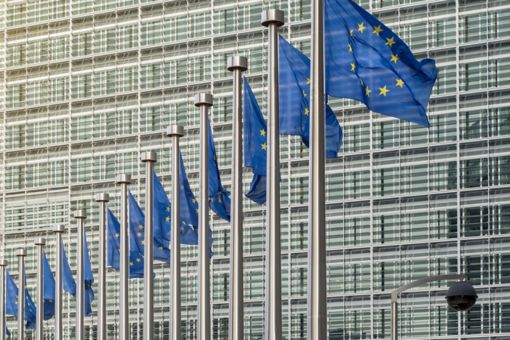The European Union’s Carbon Border Adjustment Mechanism (EU CBAM) is expected to reshape global trade at large. The regulations became effective on 17 May 2023, and with initial compliance requirements coming into force as of October 2023, all businesses that trade in covered goods directly with the EU or as part of an EU-wide supply chain need to start preparing now.
Below, we explore what the key implications are for firms here in the UK, both in terms of meeting the immediate needs of the regulations, but also what the longer-term commercial impact could be. Before going through them, let’s take a quick look at what the EU CBAM involves, and the issue it is trying to address.
Background
The EU CBAM forms part of the EU’s ‘Fit for 55’ package: a range of policy measures that aim to cut the bloc’s greenhouse gas emissions by at least 55% by 2030, compared to 1990 levels. The EU CBAM has specifically been introduced to tackle what is known as ‘carbon leakage’. This is the risk that EU businesses will try to circumvent the EU’s local carbon price either by sourcing products from, or moving production to, non-EU countries with a lower or no domestic carbon price.
The EU imposes a regional market-based carbon price through its Emissions Trading System (EU ETS), whereby energy-intensive, high-emitting industry producers are limited in the overall quantity of emissions that they are allowed to emit and must hold sufficient “allowances” to cover their embedded carbon emissions. Currently, companies either receive emission allowances for free or buy them; however, free allowances will start being phased out over a nine-year period, commencing in 2026. As the EU ETS measures are strengthened, thereby driving up the market price of EU emissions allowances, EU companies will face increased carbon costs which, without a counteractive measure, could result in carbon leakage.
The EU CBAM aims to level the playing field, by imposing an equivalent carbon price on EU importers in the form of purchased EU CBAM certificates (less any carbon price paid locally and less any free allowances allocated under the EU ETS) on certain carbon-intensive goods imported into the EU. Goods produced locally and those that are imported will therefore incur broadly the same financial cost in respect of their embedded emissions.
The intention is that by creating an equivalent regime this will remove the incentive for businesses to shift production outside of the EU. Instead, if businesses wish to minimize this cost, they will need to reduce their embedded emissions or source products with less embedded carbon content– which is the core aim of these regulations.
Commercial implications
Though an EU framework, the EU CBAM has implications for all exporters to EU Member States – including those based in the UK.
The first phase of the EU CBAM covers six product areas. UK businesses will need to consider the EU CBAM if they export goods within the following sectors to the EU:
- Electricity
- Iron and steel
- Cement
- Fertilizers
- Aluminium
- Hydrogen
There are no exemptions at a company level. The two primary exceptions for businesses are for goods of negligible value where the value of consignment does not exceed EUR 150, and those imported for military purposes.
Data and reporting
Considering all this, what will UK businesses be expected to report? While EU importers will have various reporting and measurement obligations under the EU CBAM, as suppliers to this market UK exporters will be expected to provide embedded emissions data, which must be verified from 1 January 2026, for their customers to meet these obligations.
These requirements will be set out in various implementing acts. The first (draft) implementing act, which relates to the transitional period reporting obligations and sets out rules regarding emission measurement methodologies, has been published and UK businesses should start thinking now about collating the following data:
- Quantity of imports (in tonnes or MGW for electricity)
- CN Codes of goods
- Country of origin
- Installation-specific information where goods were produced, including overall installation emissions
- Production routes
- For steel goods, the ID of the steel mill for the batch of steel goods
- Specific direct emissions of goods (CO2 equivalent per tonne)
- Indirect emissions data (insofar as relevant) for:
- Electricity consumption
- Indication of use of actual emissions or default values
- Corresponding emission factors
- Amount of indirect emissions of goods (CO2 equivalent per tonne)
UK businesses will need to ensure that their data and systems are sufficiently robust to meet these expectations, particularly in advance of 1 January 2026 when EU importers will have to start purchasing EU CBAM certificates. If exporters do not provide actual emissions data (or if it is not of sufficient quality) then the EU CBAM certificate calculations adopt several default punitive assumptions. This would make products from these exporters proportionally more expensive with a consequential potential loss of business. It is therefore in exporters’ interests to be able to provide quality, verifiable data.
Price-competitiveness
High quality data isn’t the only critical factor when it comes to market competitiveness. A company’s actual embedded emissions will begin to impact the price of its products from 2026, as importers bear the additional cost of EU CBAM certificates.
This makes the embedded emissions of covered products another new critical negotiating factor. While financial obligations will not apply for a few years, procurement lead times, plus the long-term nature of certain contracts, mean that UK exporters should start thinking now about how the EU CBAM will impact the price of their goods. Similarly, with many contracts being long-term in nature, it is important that producers can demonstrate now what steps are being taken to mitigate the future financial impact of the EU CBAM, where relevant.
To remain competitive in the EU, UK businesses should therefore consider how they can reduce the embedded emissions of their products ahead of 2026. Consider what low carbon alternatives are available and the ROI over time. It may be that while these options are more expensive now, they will generate a competitive advantage in the future. Taking steps now can also help businesses be more strategic with investments – for example, taking the time to consider what grants and incentives are available to fund any investment in decarbonization.
Looking forward
The EU CBAM is not a static piece of regulation. The intention is that, by 2030, all sectors and goods covered by the EU ETS will be within the scope of the EU CBAM. At the same time, the EU CBAM doesn’t exist in isolation: it’s an indication of where the market is going. The UK government, for example, held a consultation earlier this year to consider whether to introduce a UK CBAM from 2026.
And the pressure isn’t just regulatory. Stakeholders are demanding that businesses address their carbon footprint – and the wider environmental and social effects of their operations. Firms are simply going to have to understand that impact in depth and work hard to minimize it.
In this context, organizations should see the EU CBAM as an opportunity to respond to these expectations – and forge a competitive advantage by doing so. Decarbonization is the future for businesses; now’s the time to get started.
Authors: Frederik Cappelle, Head of Customs KPMG Belgium, Carol Newham, Partner Insurance, Tax, ESG Tax & Legal KPMG UK & Liz Harrowell - Director, Climate Risk & Strategy KPMG UK





